Beko BSSA 200 M3S User Manual
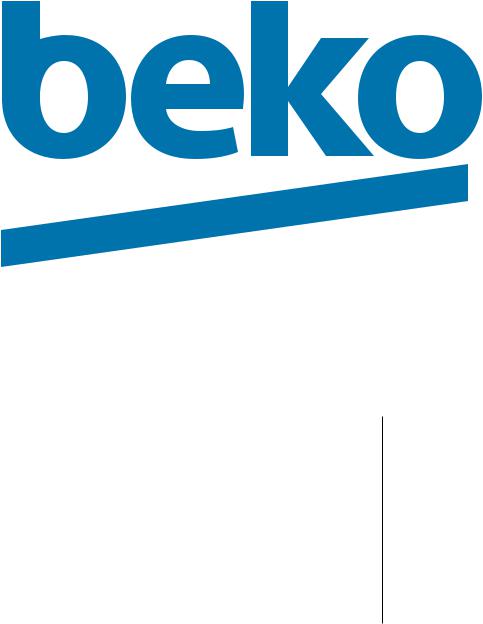
Refrigerator
Kühlschrank
Réfrigérateur
Koelkast BSSA200M3S
Lednice
Chladnička
Please read this user manual first
Dear Customer,
We hope that your product, which has been produced in modern plants and checked under the most meticulous quality control procedures, will provide you an effective service.
Therefore, read this entire user manual carefully before using the product and keep it as a reference. If you handover the product to someone else, give the user manual as well.
The user manual will help you use the product in a fast and safe way.
•Read the manual before installing and operating the product.
•Make sure you read the safety instructions.
•Keep the manual in an easily accessible place as you may need it later.
•Read the other documents given with the product.
Remember that this user manual is also applicable for several other models. Differences between models will be identified in the manual.
Explanation of symbols
Throughout this user manual the following symbols are used:
CImportant information or useful tips.
AWarning against dangerous conditions for life and property. BWarning against electric voltage.

CONTENTS
1 |
Your refrigerator |
3 |
|
4 |
Preparation |
11 |
2 |
Important Safety Warnings |
4 |
5 |
Using your refrigerator |
12 |
|
Intended use...................................... |
4 |
General safety ................................... |
4 |
For products with a water dispenser;... |
6 |
Child safety........................................ |
6 |
Compliance with the WEEE Regulation |
|
and Disposing of the Waste Product.. |
6 |
Package information.......................... |
7 |
HCA warning...................................... |
7 |
Things to be done for energy saving... |
7 |
3 Installation |
8 |
Thermostat setting button................ |
12 |
Cooling............................................ |
13 |
Freezing........................................... |
13 |
Defrost ............................................ |
13 |
Stopping your product..................... |
14 |
Bottle holder.................................... |
14 |
6 Maintenance and cleaning 15 |
|
Protection of plastic surfaces .......... |
15 |
7 Troubleshooting |
16 |
Points to be paid attention to when the |
|
relocation of the refrigerator................ |
8 |
Before you start the refrigerator,.........8 |
|
Electrical connection,.........................8 |
|
Disposing of the packaging................ |
9 |
Disposing of your old refrigerator........ |
9 |
Placing and Installation....................... |
9 |
Replacing the interior lamp ............... |
9 |
Reversing the doors ........................ |
10 |
2EN

1 Your refrigerator
1
8
8
2
3
9
4
8
3
3
5
6
10
7
1. a.) Freezing compartment & ice tray |
7. |
Crisper |
|
(for |
models) |
8. |
Adjustable door shelves |
b.) Frozen food compartment & ice tray |
9. |
Egg tray |
|
(for |
models) |
10. |
Bottle shelves |
2.Light bulb and thermostat box
3.Movable shelves
4.Bottle holder
5.Defrost water collection channel -drain tube
6.Crisper cover
C Figures that take place in this instruction manual are schematic and may not correspond exactly with your product. If the subject parts are not included in the product you have purchased, then it is valid for other models.
3EN

2 Important Safety Warnings
Please review the following information. Failure to observe this information may cause injuries or material damage. Otherwise, all warranty and reliability commitments will become invalid.
Original Spare parts will be provided for 10 years, following the product purchasing date.
Intended use
This product is intended to be used
•indoors and in closed areas such as homes;
•in closed working environments such as stores and offices;
•in closed accommodation areas such as farm houses, hotels, pensions.
•It should not be used outdoors.
General safety
•When you want to dispose/scrap the product, we recommend you to consult the authorized service in
order to learn the required information and authorized bodies.
•Consult your authorized service for all your questions and problems related to the refrigerator. Do not intervene or let someone intervene to the refrigerator without notifying the authorised services.
•For products with a freezer compartment; Do not eat cone ice cream and ice cubes immediately after you take them out of the freezer compartment! (This may cause frostbite in your mouth.)
•For products with a freezer compartment; Do not put bottled and canned liquid beverages in the freezer compartment. Otherwise, these may burst.
•Do not touch frozen food by hand; they may stick to your hand.
•Unplug your refrigerator before cleaning or defrosting.
•Vapor and vaporized cleaning materials should never be used in cleaning and defrosting processes of your refrigerator. In such cases, the vapor may get in contact with the electrical parts and cause short circuit or electric shock.
•Never use the parts on your refrigerator such as the door as a means of support or step.
•Do not use electrical devices inside the refrigerator.
•Do not damage the parts, where the refrigerant is circulating, with
drilling or cutting tools. The refrigerant that might blow out when the gas channels of the evaporator, pipe extensions or surface coatings are punctured causes skin irritations and eye injuries.
•Do not cover or block the ventilation holes on your refrigerator with any material.
•Electrical devices must be repaired by only authorised persons. Repairs performed by incompetent persons create a risk for the user.
4EN
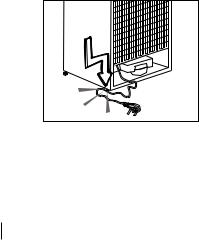
•In case of any failure or during a maintenance or repair work,
disconnect your refrigerator’s mains supply by either turning off the relevant fuse or unplugging your appliance.
•Do not pull by the cable when pulling off the plug.
•Place the beverage with higher proofs tightly closed and vertically.
•Never store spray cans containing flammable and explosive substances in the refrigerator.
•Do not use mechanical devices or other means to accelerate the
defrosting process, other than those recommended by the manufacturer.
•This product is not intended to be used by persons with physical, sensory or mental disorders or unlearned or inexperienced people (including children) unless they are attended by a person who will be responsible for their safety or who will instruct them accordingly for use of the product
•Do not operate a damaged refrigerator. Consult with the service agent if you have any concerns.
•Electrical safety of your refrigerator shall be guaranteed only if the earth system in your house complies with standards.
•Exposing the product to rain, snow, sun and wind is dangerous with respect to electrical safety.
•Contact authorized service when there is a power cable damage to avoid danger.
•Never plug the refrigerator into the wall outlet during installation. Otherwise, risk of death or serious injury may arise.
•This refrigerator is intended for only storing food items. It must not be used for any other purpose.
•Label of technical specifications is located on the left wall inside the refrigerator.
•Never connect your refrigerator to electricity-saving systems; they may damage the refrigerator.
•If there is a blue light on the refrigerator, do not look at the blue light with optical tools.
•For manually controlled refrigerators, wait for at least 5 minutes to start the refrigerator after power failure.
•This operation manual should be handed in to the new owner of the product when it is given to others.
•Avoid causing damage on power cable when transporting the refrigerator. Bending cable may cause fire. Never place heavy objects on power cable.
•Do not touch the plug with wet hands when plugging the product.
•Do not plug the refrigerator if the wall outlet is loose.
5EN

•Water should not be sprayed on inner or outer parts of the product for safety purposes.
•Do not spray substances containing inflammable gases such as propane gas near the refrigerator to avoid fire and explosion risk.
•Never place containers filled with water on top of the refrigerator; in the event of spillages, this may cause electric shock or fire.
•Do not overload the refrigerator with food. If overloaded, the food items may fall down and hurt you and damage refrigerator when you open the door.
•Never place objects on top of the refrigerator; otherwise, these objects may fall down when you open or close the refrigerator's door.
•As they require a precise temperature, vaccines, heat-sensitive medicine and scientific materials and etc. should not be kept in the refrigerator.
•If not to be used for a long time, refrigerator should be unplugged. A possible problem in power cable may cause fire.
•The plug's tip should be cleaned regularly with a dry cloth; otherwise, it may cause fire.
•Refrigerator may move if adjustable legs are not properly secured on the floor. Properly securing adjustable legs on the floor can prevent the refrigerator to move.
•When carrying the refrigerator, do not hold it from door handle. Otherwise, it may be snapped.
•When you have to place your product next to another refrigerator or freezer, the distance between devices should be at least 8cm. Otherwise, adjacent side walls may be humidified.
For products with a water dispenser;
•Pressure of water mains should be minimum 1 bar. Pressure of water mains should be maximum 8 bars.
•Use only potable water.
Child safety
•If the door has a lock, the key should be kept away from reach of children.
•Children must be supervised to prevent them from tampering with the product.
Compliance with the WEEE Regulation and Disposing of the Waste Product
This product does not contain harmful and forbidden materials described in the "Regulation on the Control of the Waste Electrical and Electronic Equipment" issued by the T.R. Ministry of Environment and
City Planning. Complies with the WEEE Regulation.
This product has been manufactured with high quality parts and materials which can bereused and
are suitable for recycling. Therefore, do not dispose the product with normal
domestic waste at the end of its service life. Take it to a collection point for the
recycling of electrical and electronic equipment. Please consult
your local authorities to learn the nearest collection
6EN

point. Help protect the environment and natural resources by recycling used products. For children's safety, cut the power cable and break the locking mechanism of the door, if any, so that it will be non-functional before disposing of the product.
Package information
Packaging materials ofthe product are manufactured from recyclable materials in accordance with our National Environment Regulations. Do not dispose of the packaging materials together with the domestic or other wastes. Take them to the packaging material collection points designated by the local authorities.
Do not forget...
Any recycled substance is an indispensable matter for nature and our national asset wealth.
If you want to contribute tothe reevaluation of the packaging materials, you can consult to your environmentalist organizations or the municipalities where you are located.
HCA warning
If your product's cooling system contains R600a:
This gas is flammable. Therefore, pay attention to not damaging the cooling system and piping during usage and transportation. In the event of damage, keep your product away from potential fire sources that can cause the product catch a fire and ventilate the roomin which the unit is placed.
Ignore this warning if your product's cooling system contains R134a.
Type of gas used in the product is stated in the type label which is on the left wall inside the refrigerator.
Never throw the product in fire for disposal.
Things to be done for energy saving
•Do not leave the doors of your refrigerator open for a long time.
•Do not put hot food or drinks in your refrigerator.
•Do not overload your refrigerator so that the air circulation inside of it is not prevented.
•Do not install your refrigerator under direct sunlight or near heat emitting appliances such as ovens, dishwashers or radiators. Keep your refrigerator at least 30cm away from heat emitting sources and at least 5cm from electrical ovens.
•Pay attention to keep your food in closed containers.
•For products with a freezer compartment; You can store maximum amount of food items in the freezer when you remove the shelf or drawer of the freezer. Energy consumption value stated for your refrigerator has been determined by removing freezer shelf or drawer and under maximum load. There
is no harm to use a shelf or drawer according to the shapes and size of food to be frozen.
•Thawing frozen food in fridge compartment will both provide energy saving and preserve the food quality.
7EN

3 Installation
B In case the information which are given in the user manual are not taken into account, manufacturer will not assume any liability for this.
Points to be paid attention to when the relocation of the refrigerator
1.Your refrigerator should be unplugged.Before transportation of your refrigerator, it should be emptied and cleaned.
2.Before it is re-packaged, shelves, accessories, crisper, etc. inside your refrigerator should be fixed with adhesive tape and secured against impacts. Package should be bound with a thick tape or sound ropes and the transportation rules on the package should be strictly observed.
3.Original packaging and foam materials should be kept for future transportations or moving.
Before you start the refrigerator,
Check the following before you start to use your refrigerator:
1. Is the interior of the refrigerator dry and can the air circulate freely in the rear of it?
2. Clean the interior of the refrigerator as recommended in the “Maintenance and cleaning” section.
3.Connect the plug of the refrigerator to the wall socket. When the fridge door is opened, fridge internal lamp will turn on.
4.When the compressor starts to operate, a sound will be heard. The liquid and gases sealed within the refrigeration system may also give rise to noise, even if the compressor is not running and this is quite normal.
5.Front edges of the refrigerator may feel warm. This is normal. These areas are designed to be warm to avoid condensation.
Electrical connection
Connect your product to a grounded
socket which is being protected by a fuse with the appropriate capacity. Important:
Theconnectionmustbein compliance with national regulations.
•The power plug must be easily accessible after installation.
•Electrical safety of your refrigerator shall be guaranteed only if the earth system in your house complies with standards.
•The voltage stated on the label located at left inner side of your product should be equal to your network voltage.
•Extension cables and multi plugs must not be used for connection.
B A damaged power cable must be replaced by a qualified electrician.
B Product must not be operated before it is repaired! There is the risk of electric shock!
8EN

Disposing of the packaging
The packing materials may be dangerous for children. Keep the packing materials out of the reach of children or dispose of them by classifying them in accordance with the waste instructions stated by your local authorities. Do not throw away with regular house waste, throw away on packaging pick up spots designated by the local authorities.
The packing of yourrefrigerator is produced from recyclable materials.
Disposing of your old refrigerator
Disposeofyourold refrigerator without giving any harm to the environment.
•You may consult your authorized dealer or waste collection center of your municipality about the disposal
of your refrigerator.
Before disposing of your refrigerator, cut out the electric plug and, if there are any locks on the door, make them inoperable in order to protect children against any danger.
Placing and Installation
A If the entrance door of the room where the refrigerator willbe
installed is not wide enough for the refrigerator to pass through, then call the authorized service to have them remove the doors of your refrigerator and pass it sideways through the door.
1.Install your refrigerator to a place that allows ease of use.
2.Keep your refrigerator away from heat sources, humid places and direct sunlight.
3.There must be appropriate air ventilation around your refrigerator in order to achieve an efficient operation. If the refrigerator is to be placed in a recess in the wall, there must be at least 5 cm distance with the ceiling and at least 5 cm with the wall. Do not place your product on the materials such as rug or carpet.
4.Place your refrigerator on an even floor surface to prevent jolts.
5.Do not keep your refrigerator in ambient temperatures under 10°C
Replacing the interior lamp
To change the Bulb/LED used for illumination of your refrigerator, call your AuthorisedService.
The lamp(s) used in this appliance is not suitable for household room illumina-tion. The intended purpose of this lamp is to assist the user to place foodstuffs in the refrigerator/freezer in a safe and comfortable way.
The lamps used in this appliance have to withstand extreme physical conditions such as temperatures below -20°C.
9EN
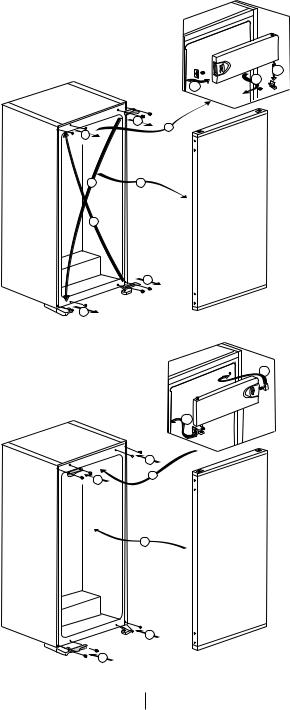
Reversing the doors
Proceed in numerical order
7
8
5
12
10
B
A
C
1
6
2
4
E
13
9
11
14
10 EN

4Preparation
•"Your refrigerator should be installed at least 30 cm away from heat sources such as hobs, ovens, central heater and stoves and at least 5
cm away from electrical ovens and should not be located under direct sunlight.
•The ambient temperature of the room where you install your refrigerator should at least be 10°C.
•Operating your refrigerator under cooler conditions than this is not recommended with regard to its efficiency
•Please make sure that the interior of your refrigerator is cleaned thoroughly."
•When you operate your refrigerator for the first time, please observe the following instructions during the initial six hours.
•The door should not be opened frequently.
•It must be operated empty without any food in it.
•Do not unplug your refrigerator. If a power failure occurs out of your control, please see the warnings in
the “Recommended solutions for the problems” section.
•Original packaging and foam materials should be kept for future transportations or moving.
11 EN

5 Using your refrigerator
Thermostat setting button
The operating temperature is regulated by the temperature control.
Warm |
|
|
|
Cold |
1 |
2 |
3 |
4 |
5 |
(Or) Min. |
|
|
|
Max. |
1 = Lowest cooling setting (Warmest setting)
5 = Highest cooling setting (Coldest setting)
(Or)
Min. = Lowest cooling setting
(Warmest setting)
Max. = Highest cooling setting
(Coldest setting)
The average temperature inside the fridge should be around +5°C.
Please choose the setting according to the desired temperature.
Please note that there will be different temperatures in the cooling area.
The coldest region is immediately above the vegetable compartment.
The interior temperature also depends on ambient temperature, the frequency with which the door is opened and the amount of foods kept inside.
Frequently opening the door causes the interior temperature to rise.
For this reason, it is recommended to close the door again as soon as possible after use.
The interior temperature of your refrigerator changes for the following reasons:
•Seasonal temperatures.
•Frequent opening of the door and leaving the door open for long periods.
•Food put into the refrigerator without cooling down to the room temperature.
•The location of the refrigerator in the room (e.g. exposing to sunlight).
•You may adjust the varying interior temperature due to such reasons by using the thermostat. Numbers around the thermostat button indicates the cooling degrees.
•If the ambient temperature is higher than 32°C, turn the thermostat button to maximum position.
•If the ambient temperature is lower than 25°C, turn the thermostat button to minimum position.
12 EN

Cooling
Food storage
The fridge compartment is for the short-term storage of fresh food and drinks.
Freezing
Freezing food
The freezing compartment is marked with  this symbol. You can use the appliance for freezing fresh food as well as for
this symbol. You can use the appliance for freezing fresh food as well as for
storing pre-frozen food. Please refer to the
recommendations given on the packaging of your food.
Storing frozen food
The frozen food compartment is marked with  symbol.
symbol.
The frozen food compartment is suitable for the storage of prefrozen food. The recommendation for storage, as stated on the food packaging, should be observed at all times.
Defrost
A) Fridge compartment
Fridge compartment performs fullautomatic defrosting.
Water drops and a frosting up to 7-8 mm can occur on the inner rear wall of the fridge compartment while your refrigerator cools down.
Such formation is normal as |
a result |
|
of the cooling system. The |
frost |
|
formation |
is defrosted by performing |
|
automatic |
defrosting with certain |
|
intervals thanks to the automatic defrosting system of the rear wall. User is not required to scrape the frost or remove the water drops.
Water resulting from the defrosting passes from the water collection groove and flows into the evaporator through the drain pipe and evaporates here by itself.
Check regularly to see ifthe drain pipe is clogged or not and clear it with the stick in the hole when necessary.
13 EN
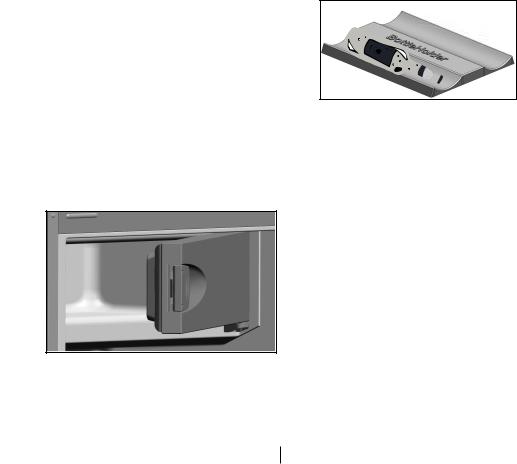
B) Freezer compartment
Deep freezer compartment does not perform automatic defrosting in order to prevent decaying of the frozen food.
Defrosting is very straightforward and without mess, thanks to a special defrost collection basin.
Defrost twice a year or when afrost layer of around 7 (1/4”) mm has formed.
To start the defrosting procedure, switch off the appliance at the socket outlet and pull out the mains plug.
All food should be wrapped in several layers of newspaper and stored in a cool place (e.g. fridge or larder).
Containers of warm water may be placed carefully in the freezer to speed up the defrosting.
Do not use pointed or sharp-edged objects, such as knives or forks to remove the frost.
Never use hair dryers, electrical heaters or other such electrical appliances for defrosting.
Sponge out the defrost water collected in the bottom of the freezer compartment. After defrosting, dry the interior thoroughly.
Insert the plug into the wall socket and switch on the electricity supply.
Stopping your product
If your thermostat is equippedwith “0” position:
-Your product will stop operating when you turn the thermostat button to “0” (zero) position. Your product will not start unless to you turn the thermostat button to position “1” or one of the other positions again.
If your thermostat isequipped with “min” position:
-Unplug your product to stop it.
Bottle holder
This accessory can be used for storing bottles or cans side by side.
14 EN

6 Maintenance and cleaning
A Never use gasoline, benzene or similar substances for cleaning purposes.
B We recommend that you unplug the appliance before cleaning.
B Never use any sharp abrasive instrument, soap, household cleaner, detergent and wax polish for cleaning.
CUse lukewarm water to clean the cabinet of your refrigerator and wipe it dry.
CUse a damp cloth wrung out in a solution of one teaspoon of
bicarbonate of soda to one pint of water to clean the interior and wipe it dry.
B Make sure that no water enters the lamp housing and other electrical items.
B If your refrigerator is not going to be used for a long period of time, unplug the power cable, remove all food, clean it and leave the door ajar.
CCheck door seals regularly to ensure they are clean and free from food particles.
A To remove door racks, remove all the contents and then simply push the door rack upwards from the base.
ANever use cleaning agents or water that contain chlorine to clean the outer surfaces and chromium coated parts of the product. Chlorine causes corrosion on such metal surfaces.
Protection of plastic surfaces
CDo not put the liquid oils or oil-cooked meals in your refrigerator in unsealed containers as they damage the plastic surfaces of your refrigerator. In case of spilling or smearing oil on the plastic surfaces, clean and rinse the relevant part of the surface at once with warm water.
15 EN

7 Troubleshooting
Please review this list before calling the service. It will save your time and money. This list includes frequent complaints that are not arising from defective workmanship or material usage. Some of the features described here may not exist in your product.
The refrigerator does not operate.
•The plug is not inserted into the socket correctly. >>>Insert the plug into the socket securely.
•The fuse of the socket which your refrigerator is connected to or the main fuse have blown out. >>>Check the fuse.
Condensation on the side wall of the fridge compartment (MULTIZONE, COOL CONTROL and FLEXI ZONE).
•Ambient is very cold. >>>Do not install the refrigerator in places where the temperature falls below 10 °C.
•Door has been opened frequently. >>>Do not open and close the door of refrigerator frequently.
•Ambient is very humid. >>>Do not install your refrigerator into highly humid places.
•Food containing liquid is stored in open containers. >>>Do not store food with liquid content in open containers.
•Door of the refrigerator is left ajar. >>>Close the door of the refrigerator.
•Thermostat is set to a very cold level. >>>Set the thermostat to a suitable level.
•Compressor is not running
•Protective thermic of the compressor will blow out during sudden power failures or plug-out plug-ins as the refrigerant pressure in the cooling system of the refrigerator has not been balanced yet. The refrigerator will start running
approximately after 6 minutes. Please call the service if the refrigerator does not startup at the end of this period.
•The fridge is in defrost cycle. >>>This is normal for a full-automatically defrosting refrigerator. Defrosting cycle occurs periodically.
•The refrigerator is not plugged into the socket. >>>Make sure that the plug is fit into the socket.
•Temperature settings are not made correctly. >>>Select the suitable temperature value.
•There is a power outage. >>>Refrigerator returns to normal operation when the power restores.
The operation noise increases when the refrigerator is running.
•The operating performance of the refrigerator may change due to the changes in the ambient temperature. It is normal and not a fault.
16 EN

The refrigerator is running frequently or for a long time.
•New product may be wider than the previous one. Larger refrigerators operate for a longer period of time.
•The room temperature may be high. >>>It is normal that the product operates for longer periods in hot ambient.
•The refrigerator might be plugged in recently or might be loaded with food.
>>>When the refrigerator is plugged in or loaded with food recently, it will take longer for it to attain the set temperature. This is normal.
•Large amounts of hot food might be put in the refrigerator recently. >>>Do not put hot food into the refrigerator.
•Doors might be opened frequently or left ajar for a long time. >>>The warm air that has entered into the refrigerator causes the refrigerator to run for longer periods. Do not open the doors frequently.
•Freezer or fridge compartment door might be left ajar. >>>Check if the doors are closed completely.
•The refrigerator is adjusted to a very low temperature. >>>Adjust the refrigerator temperature to a warmer degree and wait until the temperature is achieved.
•Door seal of the fridge or freezer may be soiled, worn out, broken or not properly seated. >>>Clean or replace the seal. Damaged/broken seal causes the refrigerator to run for a longer period of time in order to maintain the current temperature.
Freezer temperature is very low while the fridge temperature is sufficient.
•The freezer temperature is adjusted to a very low value. >>>Adjust the freezer temperature to a warmer degree and check.
Fridge temperature is very low while the freezer temperature is sufficient.
•The fridge temperature is adjusted to a very low value. >>>Adjust the fridge temperature to a warmer degree and check.
Food kept in the fridge compartment drawers is frozen.
•The fridge temperature is adjusted to a very high value. >>>Adjust the fridge temperature to a lower value and check.
17 EN

Temperature in the fridge or freezer is very high.
•The fridge temperature is adjusted to a very high value. >>>Fridge compartment temperature setting has an effect on the temperature of the freezer. Change the temperatures of the fridge or freezer and wait until the relevant compartments attain a sufficient temperature.
•Doors are opened frequently or left ajar for a long time. >>>Do not open the doors frequently.
•Door is ajar. >>>Close the door completely.
•The refrigerator is plugged in or loaded with food recently. >>>This is normal. When the refrigerator is plugged in or loaded with food recently, it will take longer for it to attain the set temperature.
•Large amounts of hot food might be put in the refrigerator recently. >>>Do not put hot food into the refrigerator.
•Vibrations or noise.
•The floor is not level or stable. >>> If the refrigerator rocks when moved slowly, balance it by adjusting its feet. Also make sure that the floor is strong enough to carry the refrigerator, and level.
•The items put onto the refrigerator may cause noise. >>>Remove the items on top of the refrigerator.
There are noises coming from the refrigerator like liquid flowing, spraying, etc.
•Liquid and gas flows occur in accordance with the operating principles of your refrigerator. It is normal and not a fault.
Whistle comes from the refrigerator.
•Fans are used in order to cool the refrigerator. It is normal and not a fault. Condensation on the inner walls of refrigerator.
•Hot and humid weather increases icing and condensation. It is normal and not a fault.
•Doors are opened frequently or left ajar for a long time. >>>Do not open the doors frequently. Close them if they are open.
•Door is ajar. >>>Close the door completely.
Humidity occurs on the outside of the refrigerator or between the doors.
•There might be humidity in the air; this is quite normal in humid weather. When the humidity is less, condensation will disappear.
Bad odour inside the refrigerator.
•No regular cleaning is performed. >>>Clean the inside of the refrigerator regularly with a sponge, lukewarm water or carbonate dissolved in water.
•Some containers or package materials may cause the smell. >>>Use a different container or different brand packaging material.
•Food is put into the refrigerator in uncovered containers. >>>Keep the food in closed containers. Microorganisms spreading out from uncovered containers can cause unpleasant odours.
•Remove the foods that have expired best before dates and spoiled from the refrigerator.
The door is not closing.
•Food packages are preventing the door from closing. >>>Replace the packages that are obstructing the door.
•The refrigerator is not completely even on the floor. >>>Adjust the feet to balance the refrigerator.
•The floor is not level or strong. >>>Make sure that the floor is level and capable to carry the refrigerator.
Crispers are stuck.
• The food is touching the ceiling of the drawer. >>>Rearrange food in the drawer.
18 EN
Bitte lesen Sie zuerst diese Anleitung!
Lieber Kunde,
Wir sind sicher, dass Ihnen dieses Produkt, das in modernsten Fertigungsstätten hergestellt und den strengsten Qualitätsprüfungen unterzogen wurde, lange Zeit gute Dienste leisten wird.
Wir empfehlen Ihnen, vor Inbetriebnahme des Gerätes das gesamte Handbuch durchzulesen und es anschließend aufzubewahren.
Diese Anleitung...
•hilft Ihnen, Ihr Gerät schnell und sicher zu bedienen.
•Lesen Sie die Anleitung, bevor Sie Ihr Gerät aufstellen und bedienen.
•Halten Sie sich an die Anweisungen, beachten Sie insbesondere die Sicherheitshinweise.
•Bewahren Sie die Anleitung an einem leicht zugänglichen Ort auf, damit Sie jederzeit darin nachschlagen können.
•Lesen Sie auch die weiteren Dokumente, die mit Ihrem Produkt geliefert wurden. Bitte beachten Sie, dass diese Anleitung eventuell auch für andere Geräte
eingesetzt werden kann.
Symbole und ihre Bedeutung
In dieser Anleitung finden Sie die folgenden Symbole:
C Wichtige Informationen oder nützliche Tipps.
AWarnung vor Verletzungen oder Sachschäden.
BWarnung vor elektrischem Strom.

INHALT
1 Ihr Kühlschrank |
3 |
2 Wichtige |
|
Sicherheitshinweise |
4 |
Bestimmungsgemäßer Einsatz........... |
4 |
Allgemeine Hinweise zu Ihrer |
|
Sicherheit........................................... |
4 |
Bei Geräten mit Wasserspender:........ |
6 |
Kinder – Sicherheit............................. |
7 |
Konformität mit der WEEE-Richtlinie |
|
zur Entsorgung von Altgeräten........... |
7 |
Hinweise zur Verpackung................... |
7 |
HCA-Warnung.................................... |
7 |
Tipps zum Energiesparen................... |
8 |
3 Installation |
9 |
Wenn Sie den Kühlschrank versetzen |
|
möchten:............................................ |
9 |
Vor dem Einschalten........................... |
9 |
ElektrischerAnschluss........................ |
9 |
Verpackungsmaterialien entsorgen... |
10 |
Altgeräte entsorgen.......................... |
10 |
Aufstellung und Installation............... |
10 |
Austausch der Innenbeleuchtung .... |
10 |
Türanschlag umkehren..................... |
11 |
4 |
Vorbereitung |
12 |
5 |
Nutzung des |
|
Kühlschranks |
13 |
|
Thermostateinstelltaste.................... |
13 |
|
Kühlen............................................. |
14 |
|
Gefrieren.......................................... |
14 |
|
Abtauen........................................... |
14 |
|
Gerät stoppen ................................. |
15 |
|
Flaschenhalter ................................. |
15 |
|
6 |
Wartung und Reinigung 16 |
|
Schutz der Kunststoffflächen .......... |
16 |
|
7 |
Problemlösung |
17 |
2DE
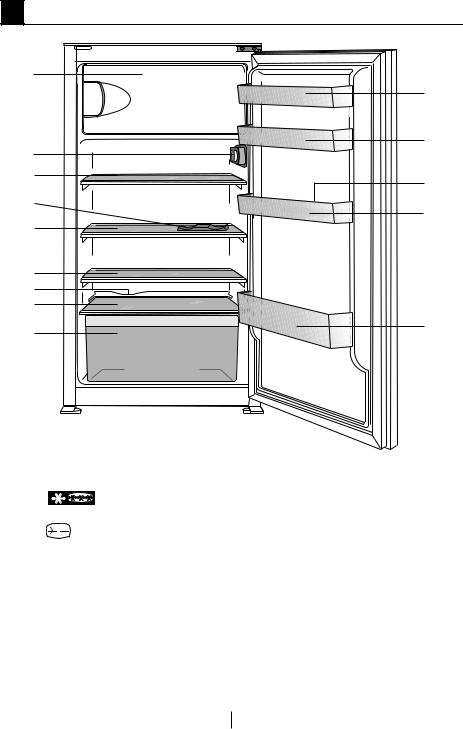
1 Ihr Kühlschrank
1
8
8
2
3
9
4
8
3
3
5
6
10
7
1. a) Tiefkühlfach und Eisschale |
7. |
Gemüsefach |
|
( |
-Modelle) |
8. |
Verstellbare Türablagen |
b) Gefriergutfach und Eisschale |
9. |
Eierbehälter |
|
( |
-Modelle) |
10. |
Flaschenablagen |
2.Innenbeleuchtung und Thermostat
3.Bewegliche Ablagen
4.Flaschenhalter
5.Tauwassersammelkanal - Abflusskanal
6.Gemüsefachabdeckung
C Abbildungen und Angaben in dieser Anleitung sind schematisch und können etwas von Ihrem Produkt abweichen. Falls Teile nicht zum Lieferumfang des erworbenen Gerätes zählen, gelten sie für andere Modelle.
3DE

2 Wichtige Sicherheitshinweise
Bitte lesen Sie die folgenden Hinweise aufmerksam durch. Bei Nichtbeachtung dieser Angaben kann es zu Verletzungen und Sachschäden kommen. In diesem Fall erlöschen auch sämtliche Garantieund sonstigen Ansprüche.
Originalersatzteile stehen für einen Zeitraum von 10 Jahren ab Kaufdatum zur Verfügung.
Bestimmungsgemäßer
Einsatz
Dieses Produkt dient dem Einsatz in
•Innenräumen und geschlossenen Bereichen, wie z. B. Haushalten;
•Das Gerät sollte nicht im Freien benutzt werden.
Allgemeine Hinweise zu Ihrer Sicherheit
•Wenn Sie das Gerät entsorgen möchten, wenden Sie sich am besten an den autorisierten Kundendienst. Hier erhalten Sie notwendige Informationen und erfahren, welche Stellen für die Entsorgung zuständig sind.
•Bei Problemen und Fragen zum Gerät wenden Sie sich grundsätzlich an den autorisierten Kundendienst. Ziehen Sie keine Dritten zu Rate, versuchen Sie nichts in Eigenregie, ohne den autorisierten Kundendienst davon in Kenntnis zu setzen.
•Bei Geräten mit Tiefkühlbereich: Der Verzehr von Speiseeis und Eiswürfeln unmittelbar nach der Entnahme aus dem Tiefkühlbereich ist nicht ratsam. (Dies kann zu Erfrierungen führen.)
•Bei Geräten mit Tiefkühlbereich: Bewahren Sie Getränke in Flaschen sowie Dosen niemals im Tiefkühlbereich auf. Diese platzen.
•Berühren Sie gefrorene Lebensmittel nicht mit der Hand; sie können festfrieren.
•Trennen Sie Ihren Kühlschrank vor dem Reinigen oder Abtauen vom Stromnetz.
•Verwenden Sie niemals Dampfoder Sprühreiniger zum Reinigen und Abtauen Ihres Kühlschranks. Die Dämpfe oder Nebel können in Kontakt mit stromführenden Teilen geraten und Kurzschlüsse oder Stromschläge auslösen.
•Missbrauchen Sie niemals Teile Ihres Kühlschranks (z. B. Tür) als Befestigungen oder Kletterhilfen.
•Nutzen Sie keine elektrischen Geräte innerhalb des Kühlschranks.
•Achten Sie darauf, den Kühlkreislauf keinesfalls mit Bohroder Schneidwerkzeugen zu beschädigen. Das Kühlmittel kann herausspritzen, wenn die Gaskanäle des Verdunsters, Rohrund Schlauchleitungen
oder Oberflächenversiegelungen beschädigt werden. Dies
kann zu Hautreizungen und Augenverletzungen führen.
4DE

•Decken Sie keinerlei Belüftungsöffnungen des Kühlschranks ab.
•Elektrische Geräte dürfen nur von autorisierten Fachkräften repariert werden. Reparaturen durch weniger kompetente Personen können erhebliche Gefährdungen des Anwenders verursachen.
•Sollten Fehler oder Probleme während der Wartung oder Reparaturarbeiten auftreten, so trennen Sie den Kühlschrank von der Stromversorgung, indem Sie die entsprechende Sicherung abschalten oder den Netzstecker ziehen.
•Ziehen Sie niemals am Netzkabel – ziehen Sie direkt am Stecker.
•Lagern Sie hochprozentige alkoholische Getränke gut verschlossen und aufrecht.
•Bewahren Sie niemals Sprühdosen mit brennbaren und explosiven Substanzen im Kühlschrank auf.
•Nutzen Sie keine mechanischen oder anderen Hilfsmittel, um das Gerät abzutauen – es sei denn, solche Hilfsmittel werden ausdrücklich vom Hersteller empfohlen.
•Dieses Produkt darf nicht von Personen (einschließlich Kindern) mit eingeschränkten physischen, sensorischen oder geistigen Fähigkeiten bedient werden, sofern sie nicht durch eine Person, die für
ihre Sicherheit verantwortlich ist, in der Bedienung des Produktes angeleitet werden.
•Nehmen Sie einen beschädigten Kühlschrank nicht in Betrieb. Wenden Sie sich bei jeglichen Zweifeln an einen Kundendienstmitarbeiter.
•Die elektrische Sicherheit des Gerätes ist nur dann gewährleistet, wenn das hausinterne Erdungssystem den zutreffenden Normen entspricht.
•Setzen Sie das Gerät keinem Regen, Schnee, direktem Sonnenlicht oder Wind aus; dies kann die elektrische Sicherheit gefährden.
•Wenden Sie sich zur Vermeidung von Gefahren an den autorisierten Kundendienst, falls das Netzkabel beschädigt ist.
•Stecken Sie während der Installation niemals den Netzstecker ein. Andernfalls kann es zu schweren bis tödlichen Verletzungen kommen.
•Dieser Kühlschrank dient nur der Aufbewahrung von Lebensmitteln. Für andere Zwecke sollte er nicht verwendet werden.
•Das Etikett mit den technischen Daten befindet sich an der linken Innenwand des Kühlschranks.
•Schließen Sie Ihren Kühlschrank niemals an energiesparende Systeme an; dies kann den Kühlschrank beschädigen.
•Falls der Kühlschrank über ein blaues Licht verfügt, blicken Sie nicht mit optischen Werkzeugen in das blaue Licht.
•Bei manuell gesteuerten Kühlschränken warten Sie mindestens 5 Minuten, bevor Sie den Kühlschrank nach einem Stromausfall wieder einschalten.
•Falls Sie das Gerät an einen anderen Besitzer weitergeben, vergessen Sie nicht, die Bedienungsanleitung ebenfalls auszuhändigen.
5DE

•Achten Sie darauf, dass das Netzkabel beim Transport des Kühlschranks nicht beschädigt wird. Übermäßiges Biegen des Kabels birgt Brandgefahr. Platzieren Sie keine schweren Gegenstände auf dem Netzkabel.
•Berühren Sie den Netzstecker niemals mit feuchten oder gar nassen Händen.
•Schließen Sie den Kühlschrank nicht an lose Steckdosen an.
•Sprühen Sie aus Sicherheitsgründen niemals Wasser auf die Innenund Außenflächen des Gerätes.
•Sprühen Sie keine Substanzen mit brennbaren Gasen, wie z. B. Propangas, in die Nähe des
Kühlschranks; andernfalls bestehen Brandund Explosionsgefahr.
•Stellen Sie keine mit Wasser gefüllten Gegenstände auf den Kühlschrank; dies birgt Brandund Stromschlaggefahr.
•Überladen Sie das Gerät nicht mit Lebensmitteln. Wenn das Gerät überladen ist, können beim Öffnen der Kühlschranktür Lebensmittel herausfallen und Verletzungen verursachen.
•Stellen Sie keinesfalls Gegenstände auf den Kühlschrank; sie könnten beim Öffnen oder Schließen der Kühlschranktür herunterfallen.
•Materialien wie beispielsweise Impfstoffe, wärmeempfindliche Arznei, wissenschaftliche Proben usw. sollten nicht im Kühlschrank aufbewahrt werden, da sie bei exakt festgelegten Temperaturen gelagert werden müssen.
•Trennen Sie den Kühlschrank vom Stromnetz, wenn er längere Zeit nicht benutzt wird. Ein mögliches Problem im Netzkabel kann einen Brand auslösen.
•Die Steckerkontakte sollten regelmäßig mit einem trockenen Tuch gereinigt werden; andernfalls besteht Brandgefahr.
•Wenn die höhenverstellbaren Füße nicht sicher auf dem Boden stehen, kann sich der Kühlschrank bewegen. Die angemessene Sicherung
der höhenverstellbaren Füße am Boden kann eine Bewegung des Kühlschranks verhindern.
•Halten Sie den Kühlschrank beim Tragen nicht am Türgriff. Andernfalls könnte er abbrechen.
•Wenn Sie Ihr Produkt neben einem anderen Kühloder Gefrierschrank aufstellen möchten, sollte der Abstand zwischen beiden Geräten mindestens 8 cm betragen. Andernfalls können die benachbarten Seitenwände feucht werden.
Bei Geräten mit
Wasserspender:
•Der Wasserdruck sollte zwischen 1 und 8 bar liegen.
•Nur Trinkwasser verwenden.
6DE

Kinder – Sicherheit
•Bei abschließbaren Türen bewahren Sie den Schlüssel außerhalb der Reichweite von Kindern auf.
•Achten Sie darauf, dass Kinder nicht mit dem Produkt spielen.
Konformität mit der WEEERichtlinie zur Entsorgung von Altgeräten
Dieses Produkt enthält keine der in der vom türkischen Ministerium für Umwelt und Städteplanung
ausgestellten „Richtlinie zur Steuerung von elektrischen und elektronischen Altgeräten“ beschriebenen gefährlichen oder verbotenen Materialien. Übereinstimmung mit WEEE-Richtlinie.
Dieses Gerät wurde mit
hochwertigen Materialien hergestellt, die
wiederverwendet und recycelt werden können.
Entsorgen Sie das Gerät am Ende seiner Einsatzzeit
daher nicht mit dem regulären Hausmüll. Bringen Sie das Gerät zu einer Sammelstelle zum Recycling von elektrischen und elektronischen Geräten. Ihre Stadtverwaltung informiert Sie gerne über Sammelstellen in Ihrer Nähe. Durch das Recycling von Altgeräten leisten Sie einen wichtigen Beitrag zum Umweltschutz und zum Erhalt natürlicher Ressourcen. Zur Sicherheit von Kindern: Schneiden Sie vor der Entsorgung des Produktes das Netzkabel ab und setzen Sie den Sperrmechanismus der Tür außer Kraft (sofern vorhanden).
Hinweise zur Verpackung
Die Verpackungsmaterialien des Gerätes wurden gemäß nationalen Umweltschutzbestimmungen aus recyclingfähigen Materialien hergestellt. Entsorgen Sie Verpackungsmaterialien nicht mit dem regulären Hausmüll oder anderen Abfällen. Bringen Sie Verpackungsmaterialien zu geeigneten Sammelstellen; Ihre Stadtverwaltung berät Sie gern.
Nicht vergessen!
Recycelte Materialien leisten einen wichtigen Beitrag zu einer schönen und gesunden Umwelt.
Wenn Sie zur Wiederverwertung von Verpackungsmaterialien
beitragen möchten, informieren Sie sich bei Ihren Umweltschutzbehörden oder der Stadtverwaltung, wo entsprechende Sammelstellen zu finden sind.
HCA-Warnung
Falls das Kühlsystem Ihres Produktes R600a enthält:
Dieses Gas ist leicht entflammbar. Achten Sie also darauf, Kühlkreislauf und Leitungen während Betrieb und Transport nicht zu beschädigen. Bei Beschädigungen halten Sie das
Produkt von potenziellen Zündquellen (z. B. offenen Flammen) fern und sorgen für eine gute Belüftung des Raumes, in dem das Gerät aufgestellt wurde.
Ignorieren Sie diese Warnung, falls das Kühlsystem Ihres Produktes R134a enthält.
Die Art des im Gerät eingesetzten Gases wird auf dem Typenschild an der linken Innenwand des
Kühlschranks angegeben. Entsorgen Sie das Produkt keinesfalls durch Verbrennen.
7DE

Tipps zum Energiesparen
•Halten Sie die Kühlschranktüren nur möglichst kurz geöffnet.
•Geben Sie keine warmen Speisen oder Getränke in den Kühlschrank.
•Überladen Sie den Kühlschrank nicht; die Luft muss frei zirkulieren können.
•Stellen Sie den Kühlschrank nicht im direkten Sonnenlicht oder in der Nähe von Wärmequellen wie Öfen, Spülmaschinen oder Heizkörpern auf. Halten Sie den Kühlschrank
mindestens 30 cm von Wärmequellen und mindestens 5 cm von elektrischen Öfen entfernt.
•Achten Sie darauf, Ihre Lebensmittel in verschlossenen Behältern aufzubewahren.
•Bei Geräten mit Tiefkühlbereich: Sie können noch mehr Lebensmittel einlagern, wenn Sie die Ablage oder Schublade aus dem Tiefkühlbereich herausnehmen. Der für Ihren Kühlschrank angegebene Energieverbrauch wurde nach dem
Entfernen der Ablage oder Schublade und bei maximaler Beladung bestimmt. Ansonsten ist es Ihnen freigestellt, die Ablage oder Schublade zu verwenden.
•Das Auftauen von gefrorenen Lebensmitteln im Kühlbereich ist energiesparend und bewahrt die Qualität der Lebensmittel.
8DE

3 Installation
B Der Hersteller haftet nicht, falls die Angaben in dieser Anleitung nicht berücksichtigt werden.
Wenn Sie den Kühlschrank versetzen möchten:
1.Ziehen Sie zuvor den Netzstecker. Der Kühlschrank sollte geleert und gesäubert werden, bevor Sie ihn transportieren oder versetzen.
2.Sichern Sie die beweglichen Teile im Inneren (z. B. Ablagen, Zubehör,
Gemüsefach etc.) vor dem Verpacken mit Klebeband, schützen Sie solche Teile vor Stößen. Umwickeln Sie die Verpackung mit kräftigem Klebeband oder stabilen Schnüren, beachten Sie die Transporthinweise auf der Verpackung.
3.Originalverpackung und Schaumstoffmaterialien sollten zum zukünftigen Transport des Gerätes aufbewahrt werden.
Vor dem Einschalten
Beachten Sie Folgendes, bevorSie Ihren Kühlschrank benutzen:
1.Ist der Innenraum des Kühlschranks trocken, kann die Luft frei an der Rückseite zirkulieren?
2.Reinigen Sie das Innere des Kühlschranks wie im Abschnitt „Wartung und Reinigung” beschrieben.
3.Schließen Sie den Netzstecker des Kühlschranks an eine Steckdose an. Beim Öffnen der Tür leuchtet die Innenbeleuchtung auf.
4.Beim Anspringen des Kompressors sind Geräusche zu hören. Die Flüssigkeiten und Gase im Kühlsystem können auch leichte Geräusche erzeugen, wenn der Kompressor nicht läuft. Dies ist völlig normal.
5.Die Vorderkanten des Kühlgerätes können sich warm anfühlen. Dies ist normal. Diese Bereiche wärmen sich etwas auf, damit sich kein Kondenswasser bildet.
Elektrischer Anschluss
Schließen Sie das |
Gerät an |
eine geerdete (Schuko-) |
|
Steckdose an. Diese |
Steckdose |
muss mit einer passenden Sicherung abgesichert werden. Wichtig:
•Der Anschluss muss gemäß lokaler Vorschriften erfolgen.
•Der Netzstecker muss nach der Installation frei zugänglich bleiben.
•Die elektrische Sicherheit des Gerätes ist nur dann gewährleistet, wenn das hausinterne Erdungssystem den zutreffenden Normen entspricht.
•Die auf dem Typenschild an der linken Innenwand des Gerätes angegebene Spannung muss mit Ihrer Netzspannung übereinstimmen.
•Zum Anschluss dürfen keine Verlängerungskabel oder Mehrfachsteckdosen verwendet werden.
9DE

B Ein beschädigtes Netzkabel muss unverzüglich durch einen qualifizierten Elektriker ausgetauscht werden.
B Das Gerät darf vor Abschluss der Reparaturen nicht mehr betrieben werden! Es besteht Stromschlaggefahr!
Verpackungsmaterialien entsorgen
Das Verpackungsmaterial kann eine Gefahr für Kinder darstellen. Halten Sie Verpackungsmaterialien von Kindern fern oder entsorgen Sie das Verpackungsmaterial gemäß gültigen Entsorgungsbestimmungen. Entsorgen Sie das Verpackungsmaterial über geeignete Sammelstellen (Ihre Stadtverwaltung informiert Sie gerne), nicht über den regulären Hausmüll.
Die Verpackung Ihres Gerätes wurde aus recyclingfähigen Materialien hergestellt.
Altgeräte entsorgen
Entsorgen Sie Altgeräte auf umweltfreundliche Weise.
•Bei Fragen zur richtigen Entsorgung wenden Sie sich bitte an Ihren Händler, an eine Sammelstelle oder
an Ihre Stadtverwaltung. Bevor Sie das Gerät entsorgen,
schneiden Sie den Netzstecker ab und machen die Türverschlüsse (sofern vorhanden) unbrauchbar, damit Kinder nicht in Gefahr gebracht werden.
Aufstellung und Installation
A Falls die Tür des Raumes, in dem der Kühlschrank aufgestellt werden
soll, nicht breit genug ist,wenden Sie sich anden autorisierten Kundendienst, lassen die Kühlschranktüren demontieren und befördern das Gerät seitlich durch die Tür.
1.Stellen Sie Ihren Kühlschrank an einer gut erreichbaren Stelle auf.
2.Platzieren Sie den Kühlschrank nicht in der Nähe von Wärmequellen oder dort, wo er Feuchtigkeit oder direktem Sonnenlicht ausgesetzt ist.
3.Damit das Gerät richtig arbeiten kann, müssen Sie ausreichend Platz um das Gerät herum freilassen, damit eine ordentliche Belüftung gewährleistet ist. Wenn Sie den Kühlschrank in einer Nische aufstellen, müssen Sie einen Abstand von mindestens 5 cm zur Decke und 5 cm zu den Wänden einhalten. Stellen Sie das Gerät nicht auf Materialien wie Teppichen oder Teppichböden auf.
4.Stellen Sie Ihren Kühlschrank auf einem ebenen Untergrund auf, damit er nicht wackelt.
5.Stellen Sie den Kühlschrank nicht an Stellen auf, an denen Temperaturen von weniger als 10 °C herrschen.
Austausch der Innenbeleuchtung
Die Innenbeleuchtung Ihres Kühlschranks sollte ausschließlich vom autorisierten Kundendienst ausgetauscht werden.
Die Glühbirnen für dieses Haushaltsgerät sind für Beleuchtungszwecke nicht geeignet. Die beabsichtigte Aufgabe dieser Lampe ist es den Benutzer zu ermöglichen die Plazierung der Lebensmittel in den Kühlschrank / Eiskühltruhe sicher und bequem vorzunehmen.
Die in diesem Gerät verwendeten Lampen müssen extremen physikalischen Bedingungen, wie z. B. Temperaturen von -20°C, standhalten.
10 DE
